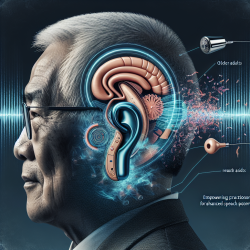Introduction
In the realm of audiology, understanding the nuances of how our ears process sound can lead to significant improvements in therapeutic practices. A recent study titled Right-Ear Advantage for Unaided and Aided Speech Perception in Noise in Older Adults sheds light on the phenomenon known as the right-ear advantage (REA) and its implications for older adults using hearing aids. This blog explores the findings of this study and offers insights for practitioners seeking to enhance their skills and improve patient outcomes.
The Right-Ear Advantage Explained
The concept of the right-ear advantage was first proposed by Kimura in the 1960s. It suggests that the right ear has a more direct pathway to the language processing centers in the left hemisphere of the brain. This advantage becomes particularly significant when processing speech in noisy environments, a common challenge for older adults with hearing loss.
Key Findings from the Study
The study investigated whether the REA for speech perception in noise decreased in aided conditions compared to unaided conditions in older adults with bilateral hearing aids. Here are some pivotal findings:
- Right-ear scores for speech perception in noise were significantly better than left-ear scores in both unaided and aided conditions.
- The magnitude of the REA did not significantly change between unaided and aided conditions.
- Audibility affected unaided speech perception in both ears similarly, but in aided conditions, audibility was associated with speech perception in the left ear only.
Implications for Practitioners
For practitioners, these findings offer several actionable insights:
- Incorporate REA in Counseling: When counseling older adults who use hearing aids, consider discussing the REA and its potential impact on their hearing experience.
- Tailor Communication Strategies: Develop communication strategies that leverage the REA, such as positioning speakers or sound sources to favor the right ear.
- Consider REA in Hearing Aid Fitting: Use the REA as a factor when fitting hearing aids, ensuring that settings are optimized to take advantage of the right-ear processing strengths.
Encouraging Further Research
While this study provides valuable insights, it also opens avenues for further research. Understanding the factors beyond audibility and age that contribute to ear differences in speech perception can lead to more effective interventions. Practitioners are encouraged to explore these areas to continue improving patient care.
Conclusion
The study on the right-ear advantage highlights the importance of considering ear-specific processing in therapeutic practices. By leveraging these insights, practitioners can enhance their skills and provide more effective support to older adults with hearing loss. To delve deeper into the research, please follow this link to read the original paper: Right-Ear Advantage for Unaided and Aided Speech Perception in Noise in Older Adults.










